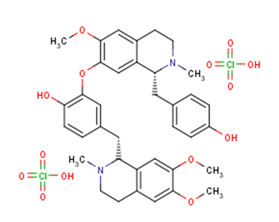
Liensinine diperchlorate
CAS No. 5088-90-4
Liensinine diperchlorate( —— )
Catalog No. M18678 CAS No. 5088-90-4
Liensinine Diperchlor?ate is a major isoquinoline alkaloid, extracted from the seed embryo of Nelumbo nucifera Gaertn.
Purity : >98% (HPLC)
 COA
COA
 Datasheet
Datasheet
 HNMR
HNMR
 HPLC
HPLC
 MSDS
MSDS
 Handing Instructions
Handing Instructions
| Size | Price / USD | Stock | Quantity |
| 5MG | 37 | In Stock |


|
| 100MG | Get Quote | In Stock |


|
| 200MG | Get Quote | In Stock |


|
| 500MG | Get Quote | In Stock |


|
| 1G | Get Quote | In Stock |


|
Biological Information
-
Product NameLiensinine diperchlorate
-
NoteResearch use only, not for human use.
-
Brief DescriptionLiensinine Diperchlor?ate is a major isoquinoline alkaloid, extracted from the seed embryo of Nelumbo nucifera Gaertn.
-
DescriptionLiensinine Diperchlor?ate is a major isoquinoline alkaloid, extracted from the seed embryo of Nelumbo nucifera Gaertn. Liensinine Diperchlor?ate inhibits late-stage autophagy/mitophagy through blocking autophagosome-lysosome fusion. Liensinine Diperchlor?ate has a wide range of biological activities, including anti-arrhythmias, anti-hypertension, anti-pulmonary fibrosis, relaxation on vascular smooth muscle, etc.
-
In Vitro——
-
In Vivo——
-
Synonyms——
-
PathwayOthers
-
TargetOther Targets
-
RecptorOthers
-
Research Area——
-
Indication——
Chemical Information
-
CAS Number5088-90-4
-
Formula Weight811.67
-
Molecular FormulaC37H44Cl2N2O14
-
Purity>98% (HPLC)
-
SolubilityIn Vitro:?DMSO : 62.5 mg/mL (77.00 mM)
-
SMILESCN1CCC2=CC(=C(C=C2C1CC3=CC=C(C=C3)O)OC4=C(C=CC(=C4)CC5C6=CC(=C(C=C6CCN5C)OC)OC)O)OC.OCl(=O)(=O)=O.OCl(=O)(=O)=O
-
Chemical Name——
Shipping & Storage Information
-
Storage(-20℃)
-
ShippingWith Ice Pack
-
Stability≥ 2 years
Reference
molnova catalog



related products
-
Alpha 1(I) Collagen ...
This is a peptide inhibitor of collagen fibrillar matrix assembly.
-
Brevinin - 1
Brevinin - 1
-
N-Acetyl-L-aspartic ...
N-Acetylaspartic acid is a derivative of aspartic acid. It is the second most concentrated molecule in the brain after the amino acid glutamate. It is synthesized in neurons from the amino acid aspartate and acetyl coenzyme A (acetyl CoA).



 Cart
Cart
 sales@molnova.com
sales@molnova.com


